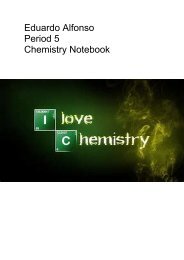You also want an ePaper? Increase the reach of your titles
YUMPU automatically turns print PDFs into web optimized ePapers that Google loves.
case, we count two things stuck to carbon, because we only count the atoms, NOT the number of<br />
bonds.<br />
Likewise, with ammonia there are four things. Three of the things on nitrogen are hydrogen atoms<br />
and the fourth is a lone pair. For the purposes of VSEPR, lone pairs count exactly the same as<br />
atoms, because they consist of negative charge, too.<br />
3. Count the number of lone pairs that are on the atom you're interested in. IMPORTANT: This<br />
does NOT mean to count the number of lone pairs on all of the atoms in the molecule. Lone<br />
pairs on other atoms aren't important - what's important is only what's directly stuck to the atom<br />
you're interested in.<br />
We mentioned above that methane has four things stuck to it. Since all four things are hydrogen<br />
atoms, we moved toward the green boxes on the flow chart. When we get to our second question,<br />
we find that there are no lone pairs on carbon, so our answer is zero. When we go down the line that<br />
says "zero" from that box, we find that methane is sp3 hybridized, with a 109.5 degree bond angle<br />
and tetrahedral shape.<br />
And, hey, that's what we were looking for!<br />
Some sample problems:<br />
What are the shapes, bond angles, and hybridizations of the following molecules? Use the flow chart<br />
and instructions above to figure it out.<br />
1. carbon tetrabromide<br />
Sp3<br />
tetrahedral<br />
109.5 degrees<br />
2. phosphorus trichloride<br />
Sp3<br />
Trigonal Pyrimid<br />
107.5 degrees<br />
3. oxygen<br />
Sp2<br />
Linear<br />
None<br />
80



